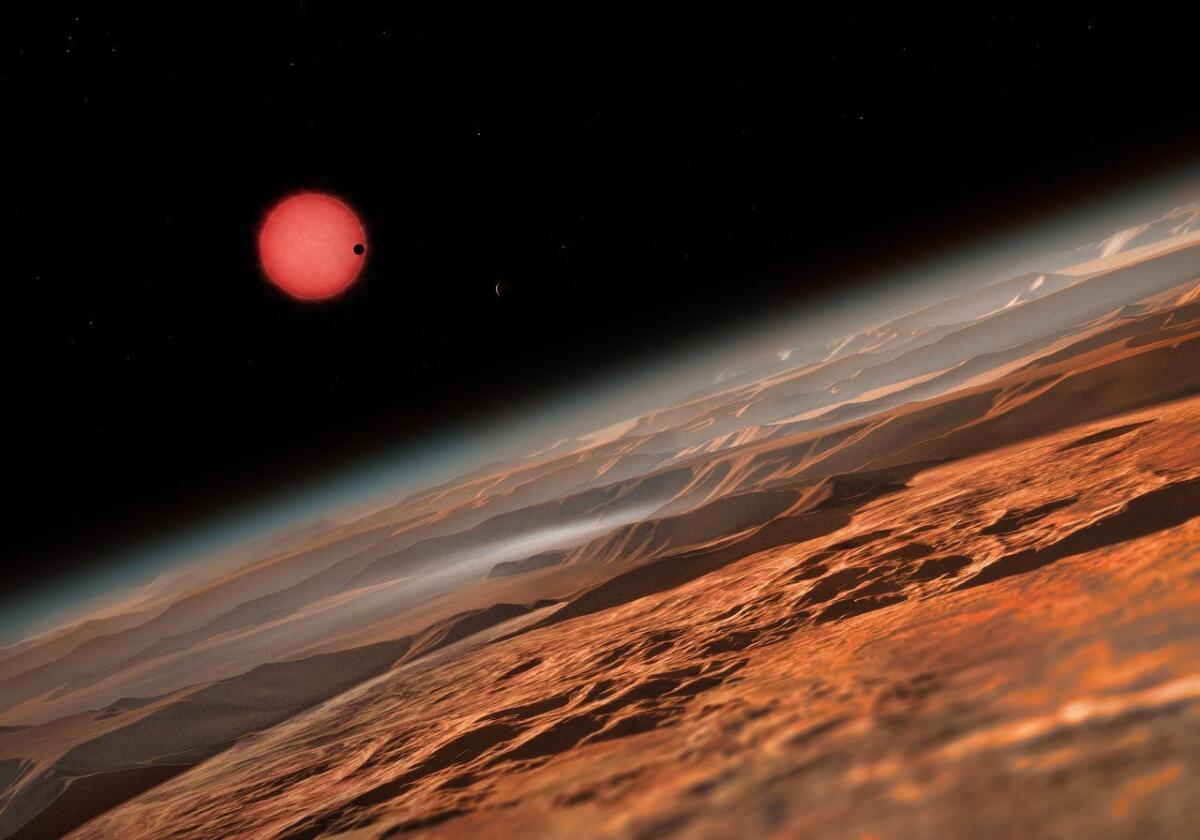Found: Three Earth-sized planets orbiting a dim, red sun. ‘This is only the beginning’

An artist’s impression of the ultracool dwarf star TRAPPIST-1 as seen just above the surface of one of its three known planets.
- Share via
Astronomers have discovered three Earth-sized planets orbiting a small red sun, just 40 light-years away.
Researchers say all three worlds are potentially habitable and could represent the best targets yet in the search for life beyond the solar system.
“These are not massive, hot, super exotic worlds,” said Julien de Wit, a postdoctoral associate in planetary science at MIT who worked on the study describing the find. “All three of them are close to one Earth [radius], and each of them could be suitable for life.”
See the most-read stories in Science this hour >>
The system’s host star, called TRAPPIST-1, is what is known as an ultracool dwarf. It is about one-tenth the size of our sun and just a bit bigger than Jupiter.
Its two innermost planets orbit extremely close to the star, taking just 1.5 and 2.4 Earth days respectively to complete a turn around the ultracool dwarf. The third planet’s orbital period is less certain: Current observations suggest it could range anywhere from 4 to 73 days.
The star is just .05% as bright as our sun, but scientists say it could still give off enough radiation to warm all three planets such that liquid water could exist on their surfaces.
A planet that is neither too hot nor too cold to sustain liquid water on its surface is generally considered to have the potential for life.
The research, published Monday in the journal Nature, was led by Michael Gillon and Emmanuel Jehin of the University of Liege in Belgium.
Ultracool dwarfs make up about 15% of the astronomical objects in our immediate neighborhood, but until now, no one had ever discovered a planet orbiting one.
That’s probably because no one was looking, de Wit explained. Most exoplanet searches, like those involving NASA’s Kepler telescope, target hotter, bigger stars.
“Before this discovery, the general opinion in the astronomy community was that ultracool dwarfs would form very small inhospitable planets -- much smaller than the Earth,” Gillon said.
In addition, these lowest-mass stars are so dim that it takes a relatively big telescope and an infrared camera to detect the telltale dimming signal that indicates a planet has passed in front of the star. Even then, there are only 1,000 of these stars in the night sky that are bright enough to allow the detection of a planet.
“The team took a big risk even looking for planets around these stars,” De Wit said. “But it has really paid off.”
The scientists say the discovery provides a unique opportunity to look for signs of life on the three Earth-sized planets that would not be possible if the bodies were orbiting brighter stars.
To determine if a planet might harbor life, scientists usually analyze the makeup of its atmosphere. Biomarkers like methane, oxygen and water could indicate that life is present.
For Earth-sized planets orbiting larger, brighter stars, the subtle signs of these molecules would be lost in the glare of the star’s light. However, in the faint glow of the red ultracool dwarf stars, the effect of the biomarkers should be big enough to be detected.
“To look for signs of life on potentially habitable Earth-sized planets, nearby ultracool dwarfs are the only option,” Gillon said.
Nikole Lewis, an astronomer working at the Space Telescope Science Institute, said the discovery is particularly exciting because the atmospheres of the three planets can be characterized with the James Webb Space Telescope, slated to launch in October 2018.
“These will be the first truly Earth-sized planets with temperatures that span the same temperatures of rocky planets in our solar system that we can study with JST,” she said.
The three planets were found with the TRAPPIST telescope -- a 60-centimeter telescope located in the Chilean desert.
The initial observations were then followed up with larger telescopes that confirmed the findings.
Going forward, the authors plan to use even more powerful telescopes to analyze the TRAPPIST-1 system. This week the Hubble Space Telescope will be pointing its powerful lens toward the ultracool dwarf star -- looking for the molecular signature of water in the planets’ atmosphere, or if they have an exosphere of hydrogen.
“Both detections would provide us our first information on the atmospheric composition and surface conditions of the planets,” Gillon said.
The research team will also look at other similar stars to see whether they might have planetary systems as well.
“This is only the beginning,” De Wit said. “There is a big adventure ahead of us.”
Do you love science? I do! Follow me @DeborahNetburn and “like” Los Angeles Times Science & Health on Facebook.
MORE SCIENCE NEWS
Scientists off Southern California explore why some fish glow
Wine and coffee lovers, drink up! It’s great for your microbiome
How the ‘Moth Radio Hour’ helped scientists map out meaning in the brain




